MK254
JF-Expert Member
- May 11, 2013
- 31,745
- 48,385
His small body washed up on the shoreline, face down as the water laps around him, the picture showing tragic Aylan Kurdi's fate has sent shockwaves across the globe.
Etched on people's hearts and minds, the image of the Syrian toddler has jolted the nation's consciousness and captured the world's attention in a way no other story about the plight of refugees has done in recent months.
Three-year-old Aylan died along with his brother Galip, five, and mother Rehan when their dinghy capsized as they tried to reach the Greek island of Kos under the cover of darkness.
Here, we look at other powerful photos that had a similar impact on the world, from the emaciated little girl stalked by a vulture in southern Sudan to the horrors of Belsen-Bergen concentration camp.
We have also focused on iconic photos capturing moments which have changed the course of history, such as the 1969 moon landing and the dropping of the atomic bomb on Hiroshima in Japan to end the Second World War.

Heartbreaking: His small body washed up on the shoreline, face down as the water laps around him, the picture showing tragic Aylan Kurdi's fate has sent shockwaves across the globe. Etched on people's hearts and minds, the image has jolted the nation's consciousness and captured the world's attention in a way no other story about the plight of refugees has done in recent months. Here are a list of other powerful photos that had a similar impact on the world...
'DUST LADY' OF 9/11

Caked from head to toe in ash as she stares aghast at the camera, Marcy Borders provided one of the most haunting images of the 9/11 disaster. She was fleeing the World Trade Center in terror when a photographer caught the astonishing shot of her. Ms Borders became known as the ‘Dust Lady' - and her subsequent tragic fate, sinking into a spiral of depression that led to alcoholism and drug addiction, became a cautionary tale about the impact that the traumatic events of September 11, 2001, had on those who survived. She died last month aged 42 after a year-long battle with stomach cancer, which she and her family blamed on the dust she inhaled during the attack
The Dust Lady: Iconic 9/11 survivor Marcy Border
POINT-BLANK EXECUTION OF VIET CONG OFFICER

South Vietnamese police chief Nguyen Ngoc Loan executes a handcuffed Viet Cong officer with a single pistol shot to the head in Saigon in 1968 during the Tet Offensive. The photo, by Eddie Adams, became one of the Vietnam War's most indelible images and would earn him a Pulitzer Prize. The image was broadcast around the world - and such was its political impact, it soured Americans' attitude towards the war by highlighting its savage reality
ASSASSINATION OF JOHN F KENNEDY

November 22, 1963 - the day President John F Kennedy was assassinated in Dallas, Texas. In this image, he is slumped down in the back seat of the presidential limousine as it speeds along Elm Street after the fatal shooting that shook the world. His wife Jacqueline leans over him as Secret Service agent Clinton Hill rides on the back of the car. Young, charismatic and wealthy, JFK's grip on America's psyche endures to this day, as do the many conspiracy theories surrounding his death
The last engagements of JFK and his Jackie in his final hours
RAISING THE FLAG ON IWO JIMA

Five US Marines and a Navy sailor were captured raising an American flag atop Mount Suribachi on the Japanese island of Iwo Jima in this photo taken on February 23, 1945. It triggered a wave of national hope that Japanese forces would soon be defeated and led to millions of Americans buying war bonds, helping to win the Second World War
ATOMIC BOMB IS DROPPED ON HIROSHIMA

On August 6, 1945, the US bomb 'Little Boy' - the first atomic weapon used at war - was dropped on Hiroshima, killing 140,000 people. A second bomb 'Fat Man,' dropped over Nagasaki three days later, killed another 70,000, prompting Japan's surrender in the Second World War. The US dropped the bombs to avoid what would have been a bloody ground assault on the Japanese mainland, following the fierce battle for Japan's southernmost Okinawan islands, which took 12,520 American lives and an estimated 200,000 Japanese, about half of whom were civilians
Hiroshima 70 years on from atomic bombin
MOON LANDING

July 20, 1969: Apollo 11 astronaut Buzz Aldrin stands on the moon, with Neil Armstrong and the lunar module reflected in his helmet visor during the historic first walk on the lunar surface. Nineteen minutes earlier, Armstrong had been the first person ever to step foot on the moon, declaring 'That's one small step for man, one giant leap for mankind'. The achievement marked the pinnacle of the space race with fellow superpower, Russia - and showcased the superiority of American technology. The Apollo project is seen as an important early step in the exploration of the solar system
MANDELA LEAVING PRISON

On February 11, 1990, to the cheers of some 2,000 well-wishers, Nelson Mandela (pictured with his wife Winnie) walked out of Victor Verster prison in Paarl, near Cape Town, South Africa, after having spent 27 years in jail. He was 71 at the time. Most of his incarceration had been on Robben Island but he was moved to Victor Verster in 1988, where he lived in a private house inside the prison compound. His release marked the beginning of a new era which led to South Africa's first all-race elections in 1994, ending years of racial oppression and violence. That year, he became South Africa's first black president after centuries of white rule, with his African National Congress (ANC) party winning 252 of the 400 seats
Nelson Mandela 1918-201
SADDAM HUSSEIN IS DRAGGED FROM HIS BOLT-HOLE

Time ran out for deposed Iraqi dictator Saddam Hussein on December 13, 2003, as US forces stormed his hiding place - a hole about 8ft deep at a remote farmhouse near Tikrit in an operation entitled Operation Red Dawn. Looking dishevelled, Saddam offered no resistance as he was captured and taken to a secure area. News of his arrest was greeted with relief and delight around the world. Afterwards Paul Bremer, head of the Coalition Provisional Authority in Iraq, told a news conference: 'Ladies and gentlemen - we got him!' But rather than ushering in a new era of peace and democracy in the region, as the Bush administration had hoped, civil war among Sunni and Shia would ensue, ultimately leading to the rise of ISIS
PRINCESS DIANA HOLDING HANDS WITH AN AIDS SUFFERER

In July 1992, Princess Diana visited the London Lighthouse AIDS centre, where she met and shook hands with a patient there, William Drake. In the early 1990s, hysteria and prejudice surrounding HIV and AIDS was at its peak. Diana became patron of the National AIDS trust in 1991 - until her death in 1997 - and her campaigning did much to tackle the stigma associated with the virus. By simply holding the hand of someone with HIV/AIDS, the princess was credited with changing the attitude of millions of people towards the condition
VJ DAY IN TIMES SQUARE

On August 14, 1945, as Japan surrendered at the end of the Second World War, celebrations broke out in New York City's Times Square. And famously, during the VJ (Victory over Japan) Day celebrations, a sailor and a woman embraced in a passionate kiss. Mystery surrounds the subjects in the photo, taken by photographer Alfred Eisenstaedt. Over the past 70 years, dozens of men and women have claimed to be the pair caught in the clinch
CHILD IS STALKED BY A VULTURE IN SUDAN

Seen as a ‘metaphor for Africa's despair', when this picture was published in the New York Times in 1993 it led to hundreds of people writing in to ask what became of the child. The image of a vulture preying upon an emaciated toddler was taken in southern Sudan by photographer Kevin Carter, who faced criticism for not helping the girl. Tragically, he killed himself three months after the picture was published
KHMER ROUGE BONES

The Khmer Rouge, led by Pol Pot in Cambodia between 1975 and 1979, was behind about 2million deaths across the country. Victims – particularly the educated and intellectual elite – were starved, tortured, raped and murdered. Pol Pot's radical policies essentially turned all of Cambodia into a forced labour camp. 'Enemies' were forced to endure horrific torture methods at Tuol Sleng Genocide prison, a former high school. Some 15,000 Cambodians passed through here before being taken to sites known as The Killing Fields outside the capital Phnom Penh. They were then executed mainly by pickaxes and buried in mass graves. Vietnam sponsored a resistance movement and invaded, ousting the Khmer Rouge in 1979. Continued political feuds and the absence of an educated class has led some to believe it will take generations for Cambodia to recover from the catastrophic actions of Pol Pot
TERRIFIED GIRL RUNS FOR HER LIFE AFTER VIETNAM WAR NAPALM ATTACK

This photo, taken by Vietnamese-born war photographer Nick Ut in 1973, captured the face of a terrified nine-year-old girl seen running for her life after ripping off her burning clothes when a South Vietnamese plane accidentally dropped napalm on its own troops and civilians. The image horrified people around the world and some believe it hastened the end of the Vietnam War
US soldiers on patrol advance through Vietnam jungle in 1960s
MAKING A STAND IN TIANANMEN SQUARE

A Peking citizen stands in front of tanks during the crushing of the Tiananmen Square uprising in June 1989. China allows no public discussion of the massacre, when soldiers backed by tanks and armoured personnel carriers fought their way into the heart of Beijing (then known as Peking), killing hundreds of unarmed pro-democracy protesters and onlookers. In one of the greatest challenges to the communist state, the protesters - mainly students - had occupied the square for seven weeks, and had refused to leave until their voices were heard. Last year marked the 25th anniversary of the bloody suppression - but there was heavy security to stop any attempts to publicly commemorate one of the darkest chapters in the country's history. Despite China's discouragement, the crackdown is recalled with rallies and commemorations in Chinese communities worldwide, especially in Hong Kong
Archive footage shows Chinese crackdown at Tiananmen square
HORRORS OF ABU GHRAIB PRISON

It is the image that shamed America. Acts of torture and prisoner abuse carried out by the US Army at the Iraqi prison Abu Ghraib came to light after this picture was published. Accusations of physical and mental abuse, rape, torture and murder in the aftermath of the 2003 Iraq invasion received widespread condemnation both within the United States and abroad. One of the images to surface showed a detainee being led on a dog leash. Eleven US soldiers were convicted in military trials of crimes related to the humiliation and abuse of the prisoners
LIBERATION OF BERGEN-BELSEN CONCENTRATION CAMP

April 1945: Fritz Klein, a Nazi camp doctor who conducted medical experiments on prisoners during the Holocaust, stands among corpses in a mass grave after the liberation of Bergen-Belsen, Germany. Of the 38,500 inmates found barely alive after liberation, about 28,000 subsequently died. Watched by British soldiers, Klein is pictured here being forced to bury the dead. That December, he was sentenced to death and hanged for his role in the atrocities. Bergen-Belsen was the first Nazi camp to be liberated - and gave the world some of the first visual evidence of the horrors of the Holocaust
Aylan Kurdi's body is among photos that have changed history
Etched on people's hearts and minds, the image of the Syrian toddler has jolted the nation's consciousness and captured the world's attention in a way no other story about the plight of refugees has done in recent months.
Three-year-old Aylan died along with his brother Galip, five, and mother Rehan when their dinghy capsized as they tried to reach the Greek island of Kos under the cover of darkness.
Here, we look at other powerful photos that had a similar impact on the world, from the emaciated little girl stalked by a vulture in southern Sudan to the horrors of Belsen-Bergen concentration camp.
We have also focused on iconic photos capturing moments which have changed the course of history, such as the 1969 moon landing and the dropping of the atomic bomb on Hiroshima in Japan to end the Second World War.
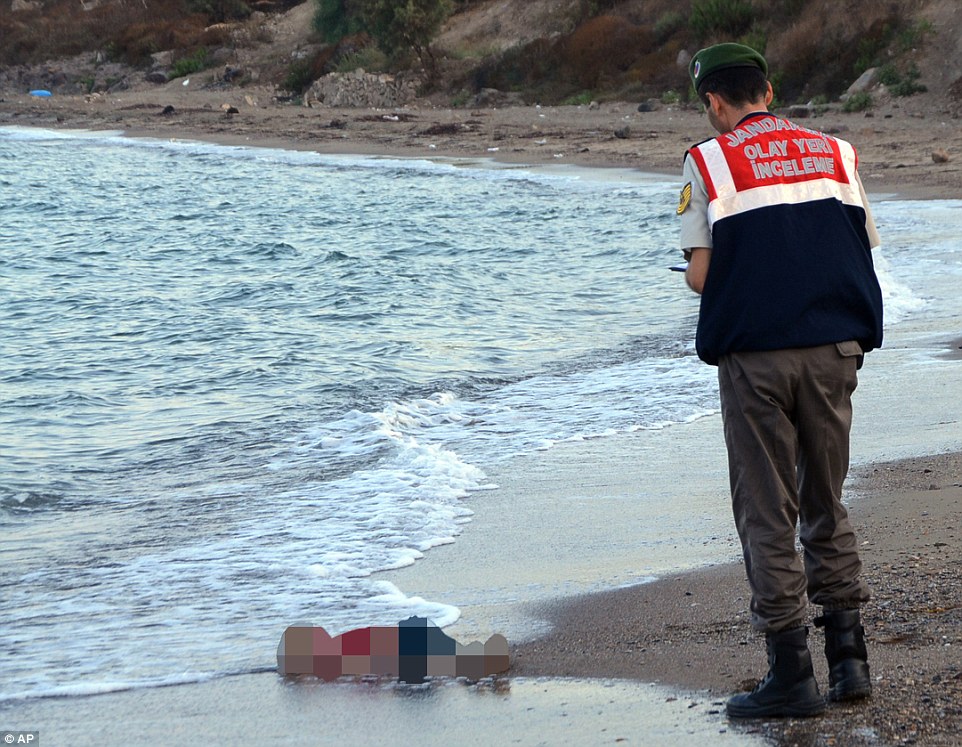
Heartbreaking: His small body washed up on the shoreline, face down as the water laps around him, the picture showing tragic Aylan Kurdi's fate has sent shockwaves across the globe. Etched on people's hearts and minds, the image has jolted the nation's consciousness and captured the world's attention in a way no other story about the plight of refugees has done in recent months. Here are a list of other powerful photos that had a similar impact on the world...
'DUST LADY' OF 9/11
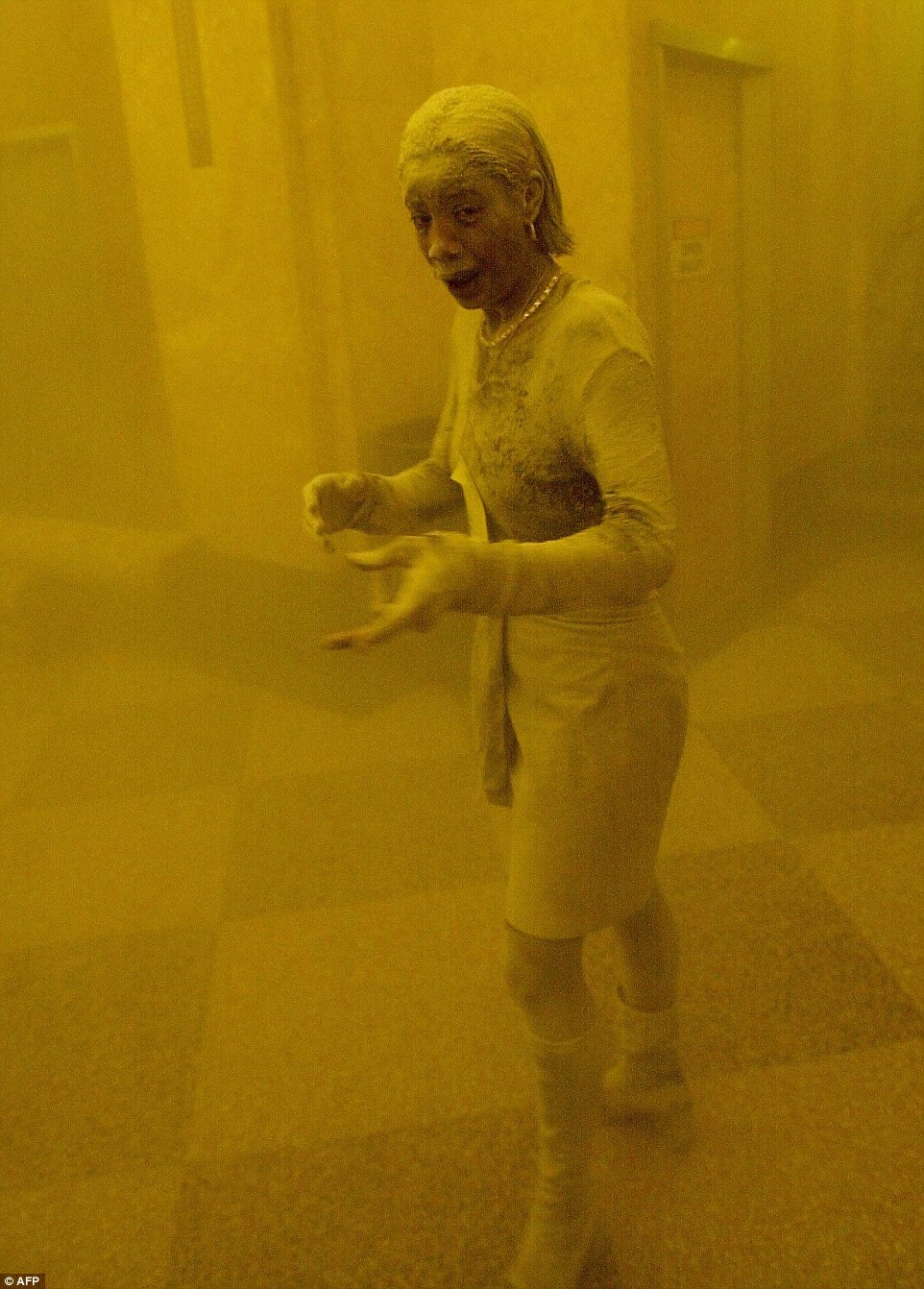
Caked from head to toe in ash as she stares aghast at the camera, Marcy Borders provided one of the most haunting images of the 9/11 disaster. She was fleeing the World Trade Center in terror when a photographer caught the astonishing shot of her. Ms Borders became known as the ‘Dust Lady' - and her subsequent tragic fate, sinking into a spiral of depression that led to alcoholism and drug addiction, became a cautionary tale about the impact that the traumatic events of September 11, 2001, had on those who survived. She died last month aged 42 after a year-long battle with stomach cancer, which she and her family blamed on the dust she inhaled during the attack
The Dust Lady: Iconic 9/11 survivor Marcy Border
POINT-BLANK EXECUTION OF VIET CONG OFFICER
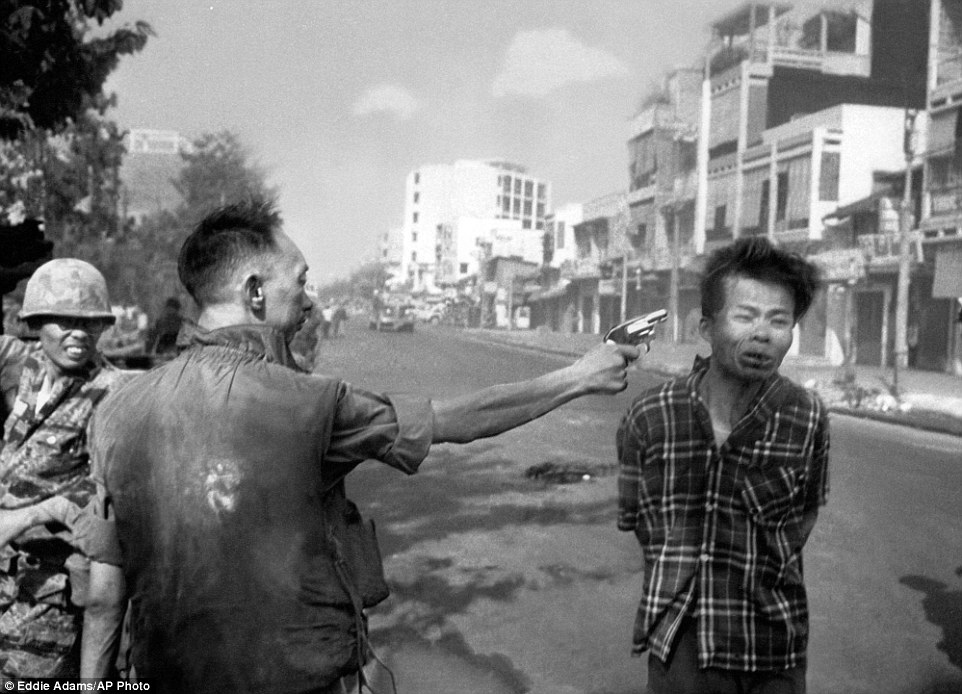
South Vietnamese police chief Nguyen Ngoc Loan executes a handcuffed Viet Cong officer with a single pistol shot to the head in Saigon in 1968 during the Tet Offensive. The photo, by Eddie Adams, became one of the Vietnam War's most indelible images and would earn him a Pulitzer Prize. The image was broadcast around the world - and such was its political impact, it soured Americans' attitude towards the war by highlighting its savage reality
ASSASSINATION OF JOHN F KENNEDY
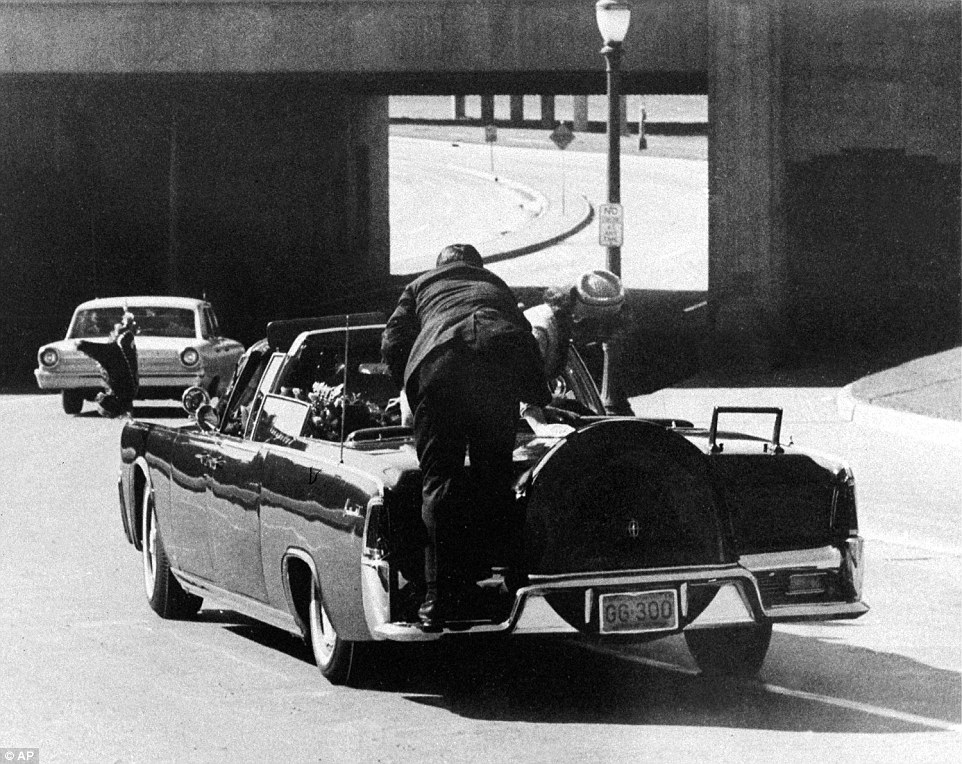
November 22, 1963 - the day President John F Kennedy was assassinated in Dallas, Texas. In this image, he is slumped down in the back seat of the presidential limousine as it speeds along Elm Street after the fatal shooting that shook the world. His wife Jacqueline leans over him as Secret Service agent Clinton Hill rides on the back of the car. Young, charismatic and wealthy, JFK's grip on America's psyche endures to this day, as do the many conspiracy theories surrounding his death
The last engagements of JFK and his Jackie in his final hours
RAISING THE FLAG ON IWO JIMA
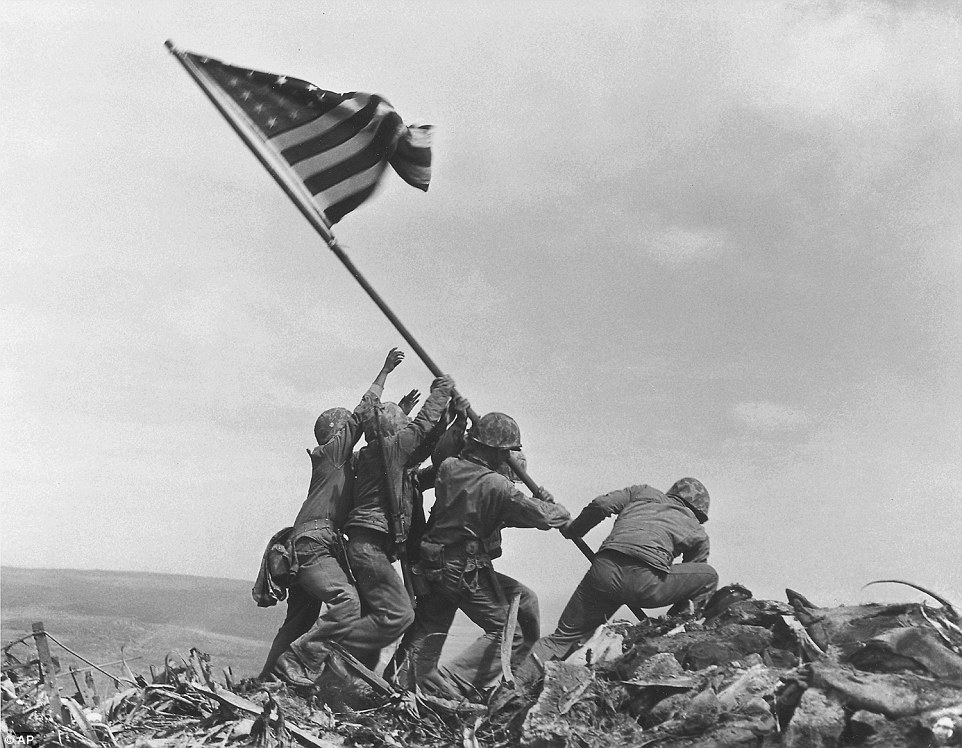
Five US Marines and a Navy sailor were captured raising an American flag atop Mount Suribachi on the Japanese island of Iwo Jima in this photo taken on February 23, 1945. It triggered a wave of national hope that Japanese forces would soon be defeated and led to millions of Americans buying war bonds, helping to win the Second World War
ATOMIC BOMB IS DROPPED ON HIROSHIMA
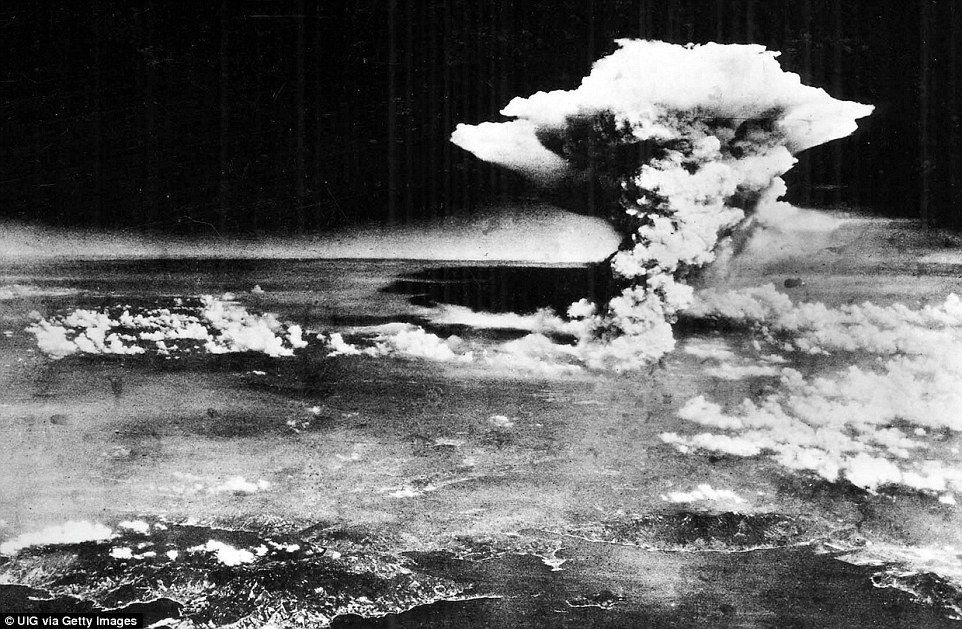
On August 6, 1945, the US bomb 'Little Boy' - the first atomic weapon used at war - was dropped on Hiroshima, killing 140,000 people. A second bomb 'Fat Man,' dropped over Nagasaki three days later, killed another 70,000, prompting Japan's surrender in the Second World War. The US dropped the bombs to avoid what would have been a bloody ground assault on the Japanese mainland, following the fierce battle for Japan's southernmost Okinawan islands, which took 12,520 American lives and an estimated 200,000 Japanese, about half of whom were civilians
Hiroshima 70 years on from atomic bombin
MOON LANDING
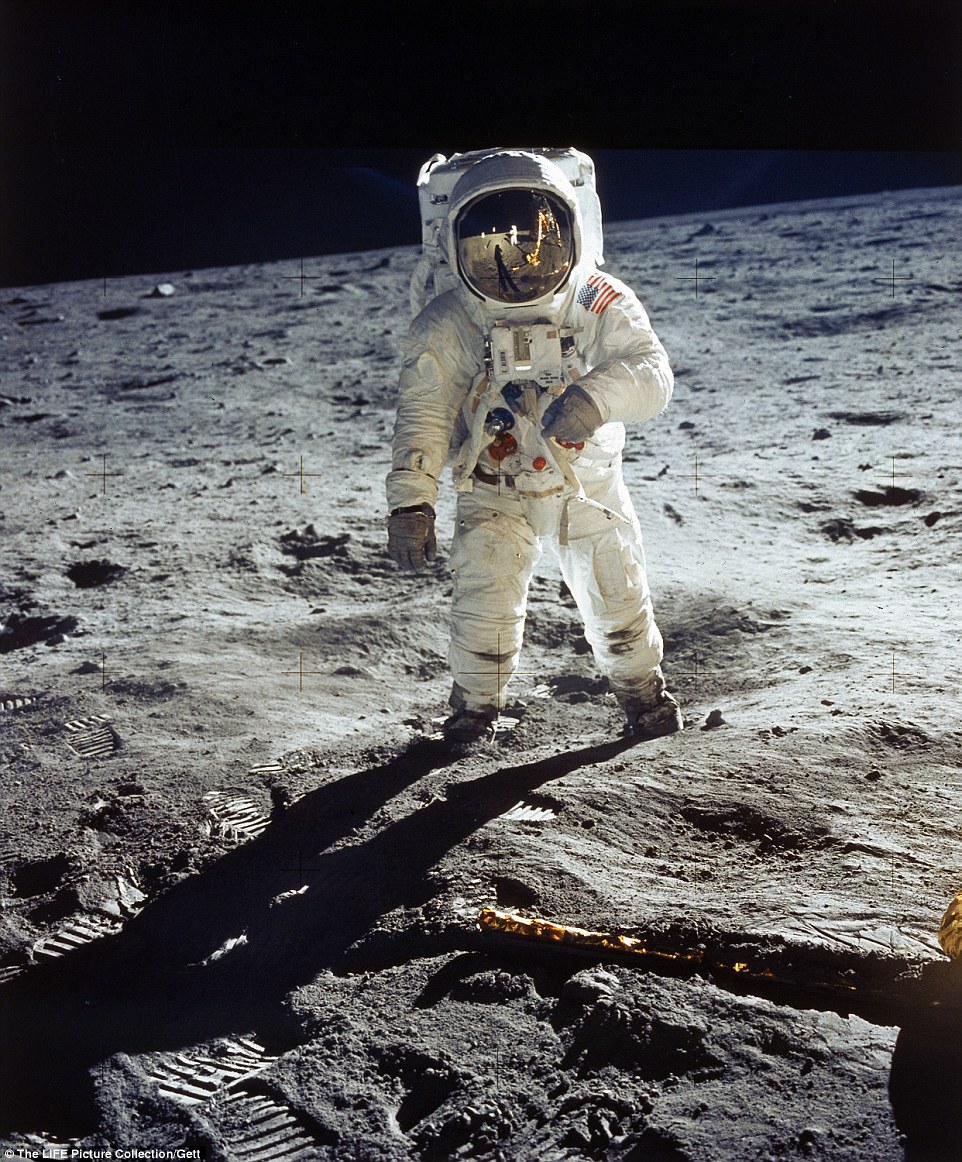
July 20, 1969: Apollo 11 astronaut Buzz Aldrin stands on the moon, with Neil Armstrong and the lunar module reflected in his helmet visor during the historic first walk on the lunar surface. Nineteen minutes earlier, Armstrong had been the first person ever to step foot on the moon, declaring 'That's one small step for man, one giant leap for mankind'. The achievement marked the pinnacle of the space race with fellow superpower, Russia - and showcased the superiority of American technology. The Apollo project is seen as an important early step in the exploration of the solar system
MANDELA LEAVING PRISON
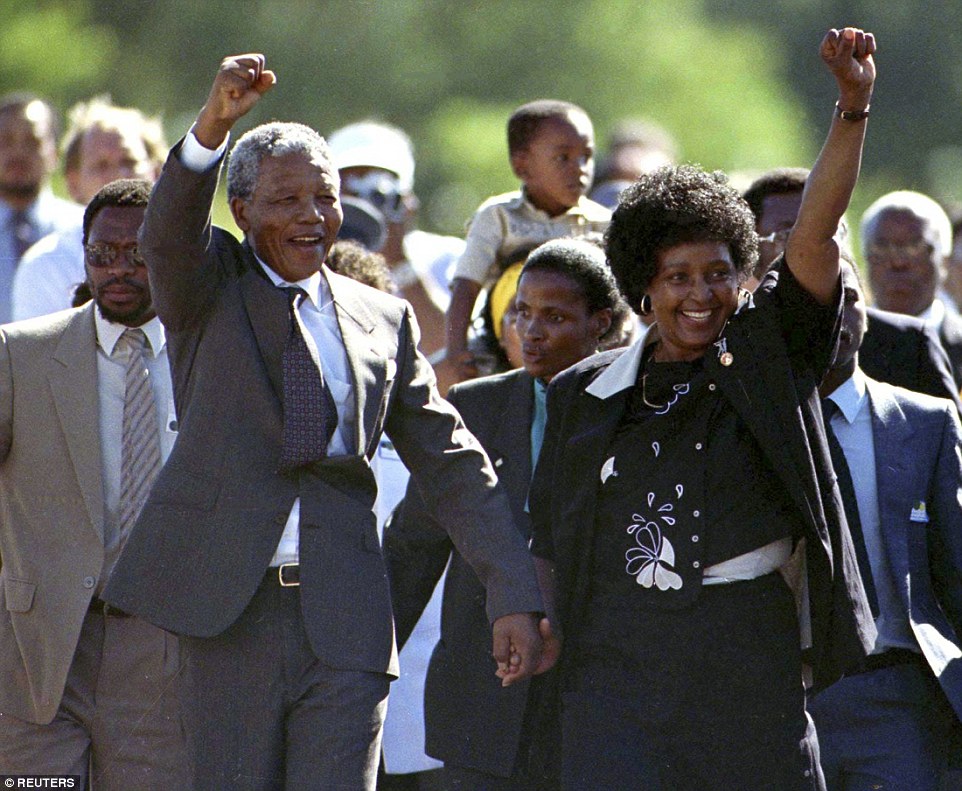
On February 11, 1990, to the cheers of some 2,000 well-wishers, Nelson Mandela (pictured with his wife Winnie) walked out of Victor Verster prison in Paarl, near Cape Town, South Africa, after having spent 27 years in jail. He was 71 at the time. Most of his incarceration had been on Robben Island but he was moved to Victor Verster in 1988, where he lived in a private house inside the prison compound. His release marked the beginning of a new era which led to South Africa's first all-race elections in 1994, ending years of racial oppression and violence. That year, he became South Africa's first black president after centuries of white rule, with his African National Congress (ANC) party winning 252 of the 400 seats
Nelson Mandela 1918-201
SADDAM HUSSEIN IS DRAGGED FROM HIS BOLT-HOLE
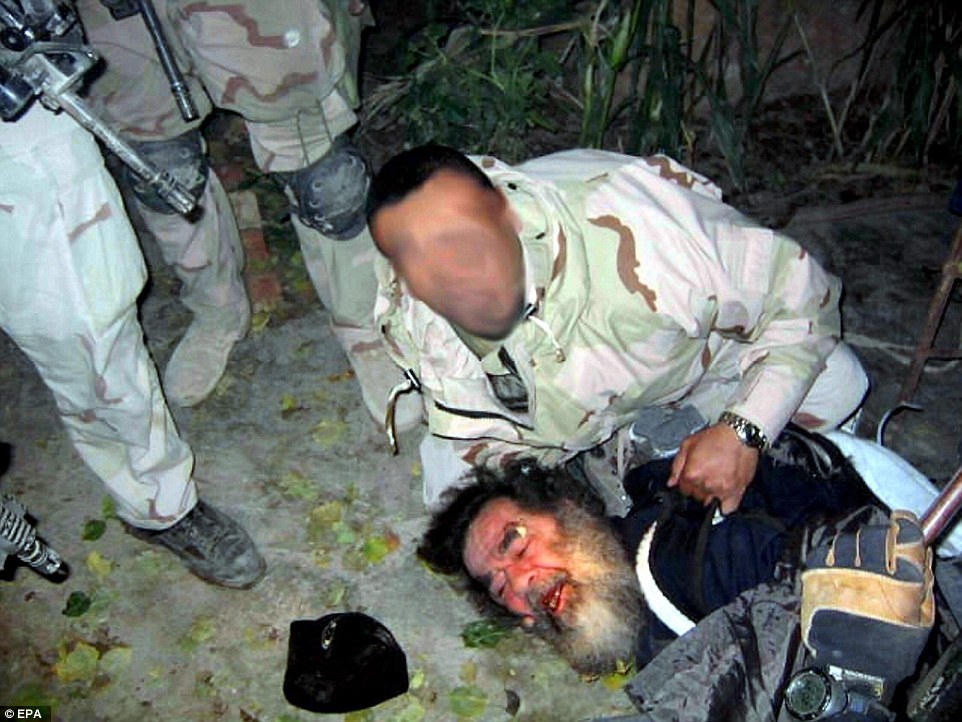
Time ran out for deposed Iraqi dictator Saddam Hussein on December 13, 2003, as US forces stormed his hiding place - a hole about 8ft deep at a remote farmhouse near Tikrit in an operation entitled Operation Red Dawn. Looking dishevelled, Saddam offered no resistance as he was captured and taken to a secure area. News of his arrest was greeted with relief and delight around the world. Afterwards Paul Bremer, head of the Coalition Provisional Authority in Iraq, told a news conference: 'Ladies and gentlemen - we got him!' But rather than ushering in a new era of peace and democracy in the region, as the Bush administration had hoped, civil war among Sunni and Shia would ensue, ultimately leading to the rise of ISIS
PRINCESS DIANA HOLDING HANDS WITH AN AIDS SUFFERER
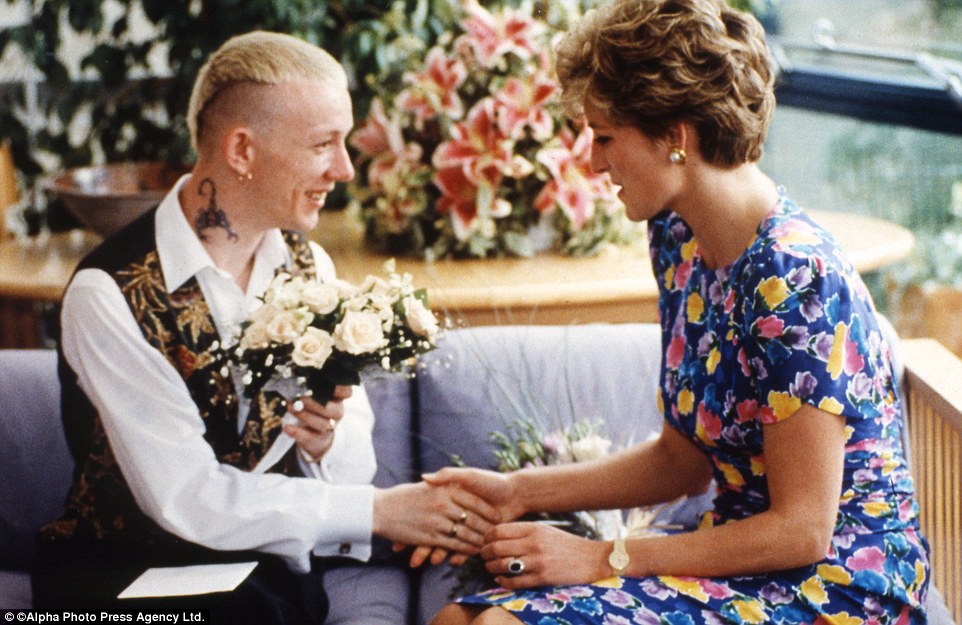
In July 1992, Princess Diana visited the London Lighthouse AIDS centre, where she met and shook hands with a patient there, William Drake. In the early 1990s, hysteria and prejudice surrounding HIV and AIDS was at its peak. Diana became patron of the National AIDS trust in 1991 - until her death in 1997 - and her campaigning did much to tackle the stigma associated with the virus. By simply holding the hand of someone with HIV/AIDS, the princess was credited with changing the attitude of millions of people towards the condition
VJ DAY IN TIMES SQUARE
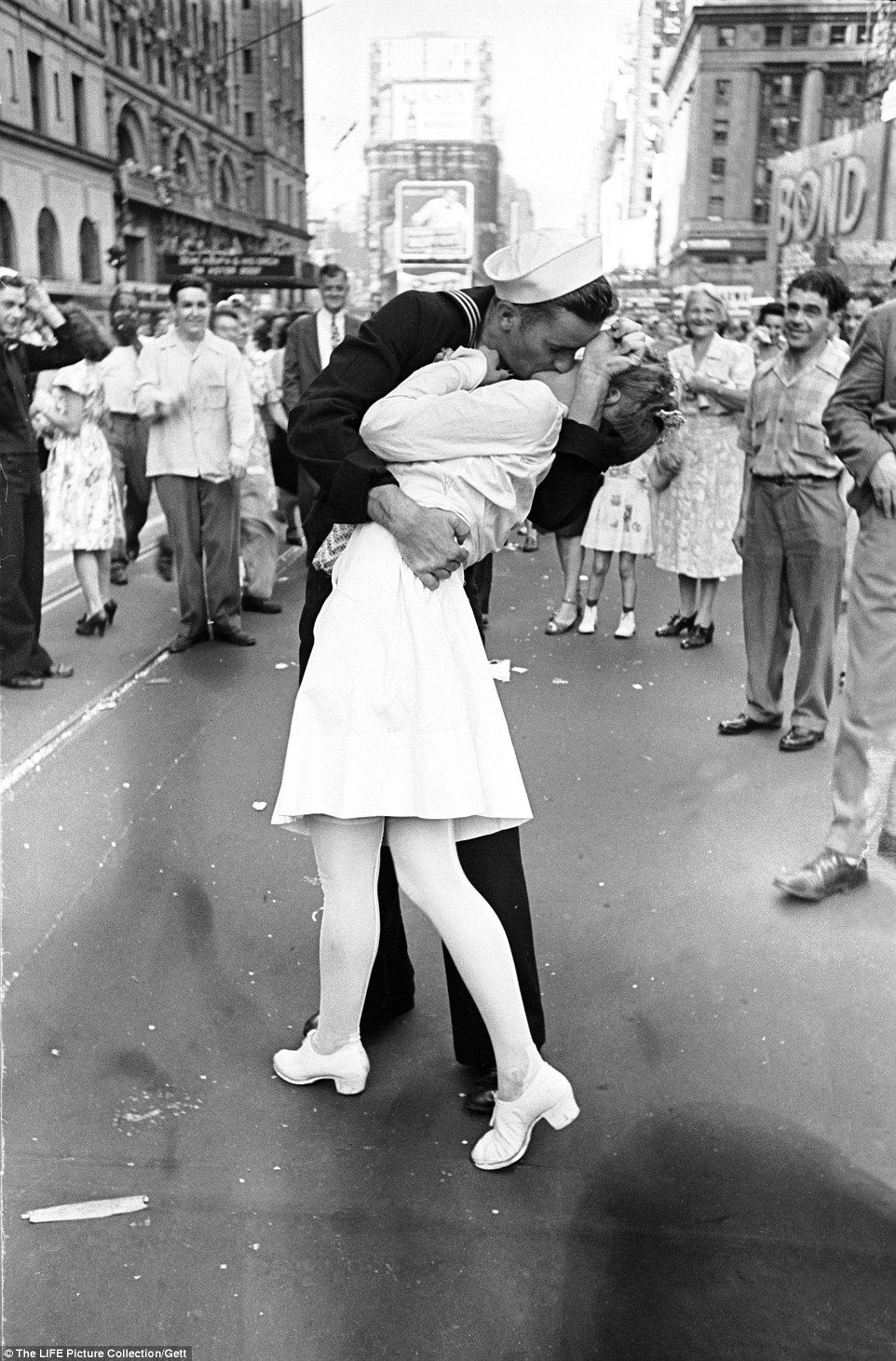
On August 14, 1945, as Japan surrendered at the end of the Second World War, celebrations broke out in New York City's Times Square. And famously, during the VJ (Victory over Japan) Day celebrations, a sailor and a woman embraced in a passionate kiss. Mystery surrounds the subjects in the photo, taken by photographer Alfred Eisenstaedt. Over the past 70 years, dozens of men and women have claimed to be the pair caught in the clinch
CHILD IS STALKED BY A VULTURE IN SUDAN
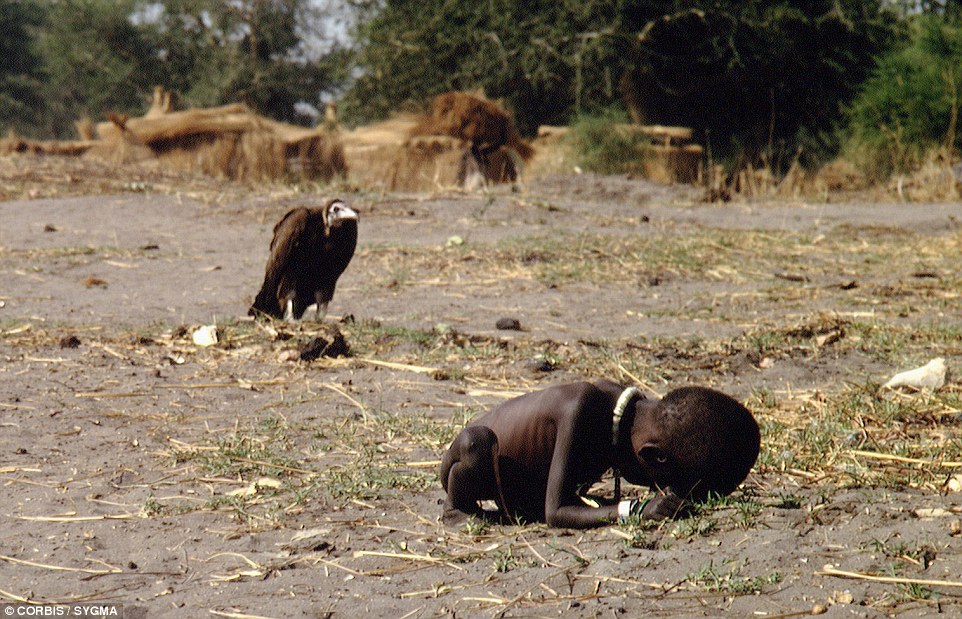
Seen as a ‘metaphor for Africa's despair', when this picture was published in the New York Times in 1993 it led to hundreds of people writing in to ask what became of the child. The image of a vulture preying upon an emaciated toddler was taken in southern Sudan by photographer Kevin Carter, who faced criticism for not helping the girl. Tragically, he killed himself three months after the picture was published
KHMER ROUGE BONES
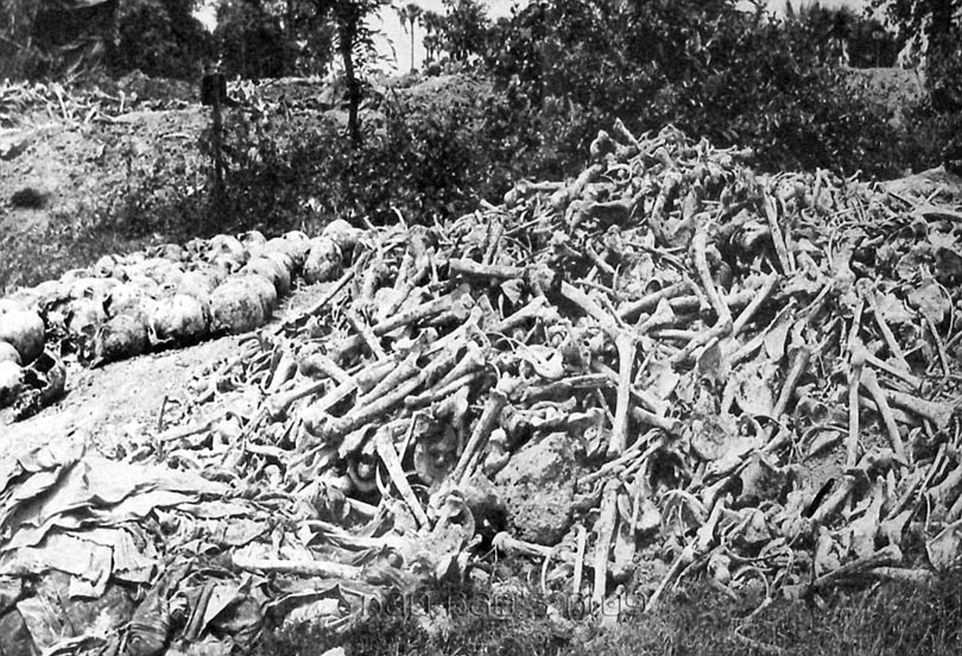
The Khmer Rouge, led by Pol Pot in Cambodia between 1975 and 1979, was behind about 2million deaths across the country. Victims – particularly the educated and intellectual elite – were starved, tortured, raped and murdered. Pol Pot's radical policies essentially turned all of Cambodia into a forced labour camp. 'Enemies' were forced to endure horrific torture methods at Tuol Sleng Genocide prison, a former high school. Some 15,000 Cambodians passed through here before being taken to sites known as The Killing Fields outside the capital Phnom Penh. They were then executed mainly by pickaxes and buried in mass graves. Vietnam sponsored a resistance movement and invaded, ousting the Khmer Rouge in 1979. Continued political feuds and the absence of an educated class has led some to believe it will take generations for Cambodia to recover from the catastrophic actions of Pol Pot
TERRIFIED GIRL RUNS FOR HER LIFE AFTER VIETNAM WAR NAPALM ATTACK
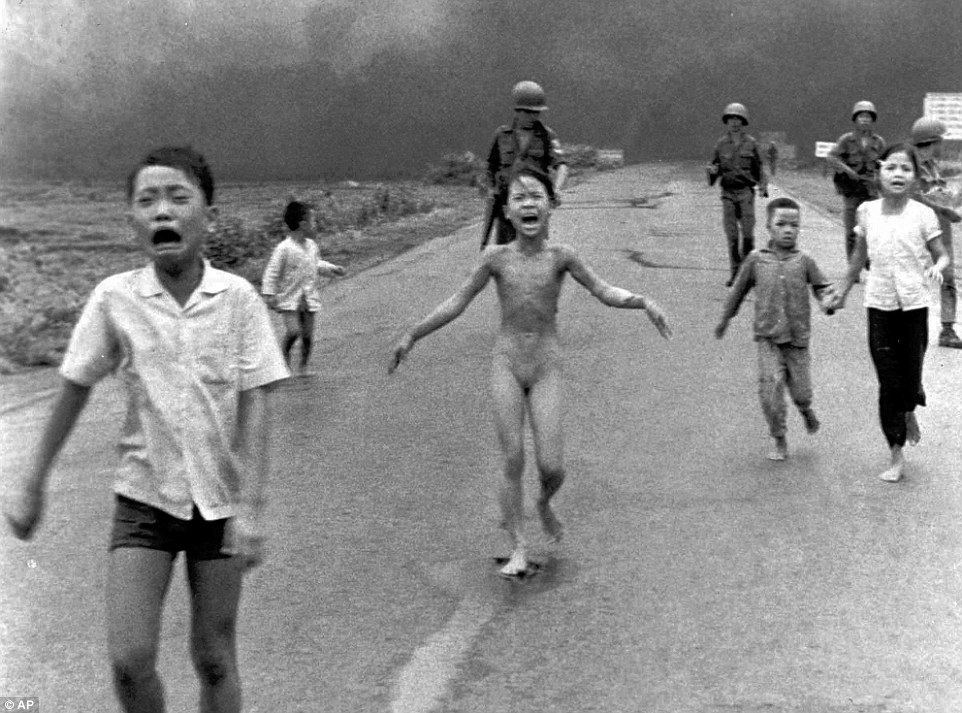
This photo, taken by Vietnamese-born war photographer Nick Ut in 1973, captured the face of a terrified nine-year-old girl seen running for her life after ripping off her burning clothes when a South Vietnamese plane accidentally dropped napalm on its own troops and civilians. The image horrified people around the world and some believe it hastened the end of the Vietnam War
US soldiers on patrol advance through Vietnam jungle in 1960s
MAKING A STAND IN TIANANMEN SQUARE
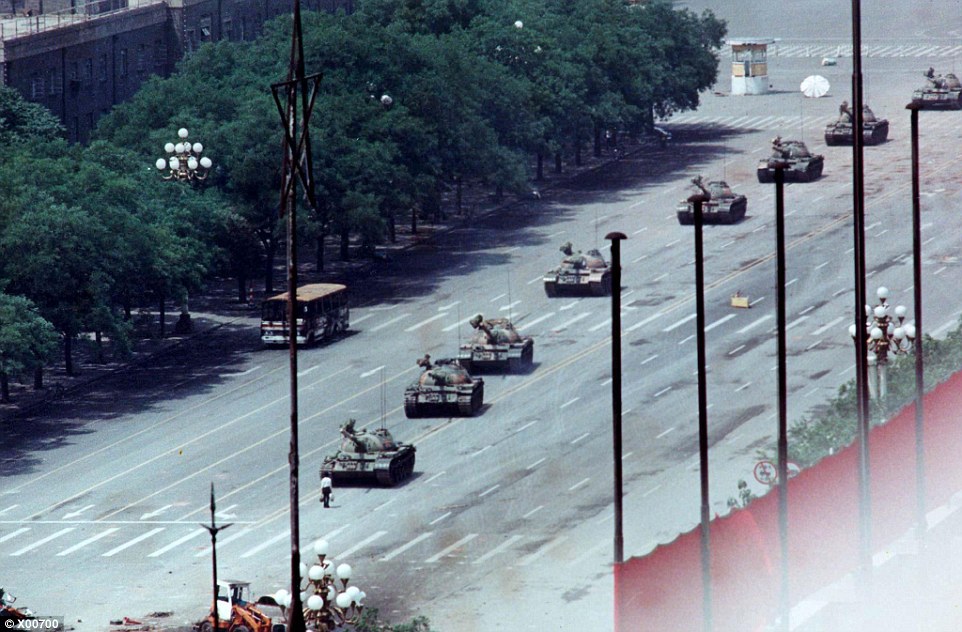
A Peking citizen stands in front of tanks during the crushing of the Tiananmen Square uprising in June 1989. China allows no public discussion of the massacre, when soldiers backed by tanks and armoured personnel carriers fought their way into the heart of Beijing (then known as Peking), killing hundreds of unarmed pro-democracy protesters and onlookers. In one of the greatest challenges to the communist state, the protesters - mainly students - had occupied the square for seven weeks, and had refused to leave until their voices were heard. Last year marked the 25th anniversary of the bloody suppression - but there was heavy security to stop any attempts to publicly commemorate one of the darkest chapters in the country's history. Despite China's discouragement, the crackdown is recalled with rallies and commemorations in Chinese communities worldwide, especially in Hong Kong
Archive footage shows Chinese crackdown at Tiananmen square
HORRORS OF ABU GHRAIB PRISON
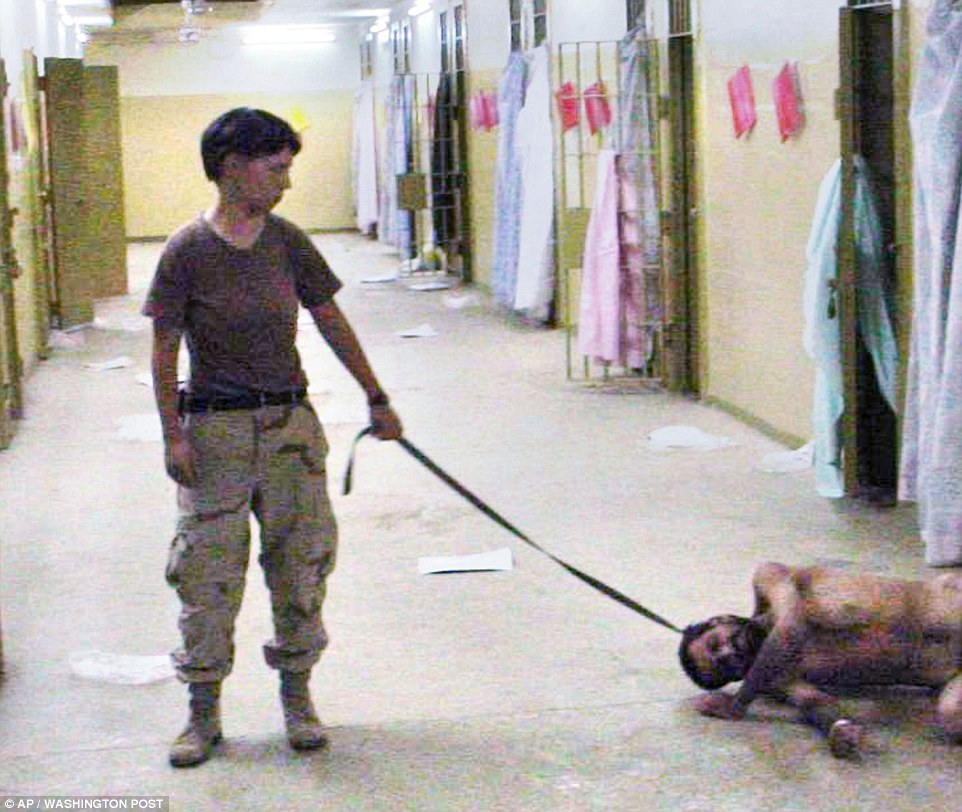
It is the image that shamed America. Acts of torture and prisoner abuse carried out by the US Army at the Iraqi prison Abu Ghraib came to light after this picture was published. Accusations of physical and mental abuse, rape, torture and murder in the aftermath of the 2003 Iraq invasion received widespread condemnation both within the United States and abroad. One of the images to surface showed a detainee being led on a dog leash. Eleven US soldiers were convicted in military trials of crimes related to the humiliation and abuse of the prisoners
LIBERATION OF BERGEN-BELSEN CONCENTRATION CAMP
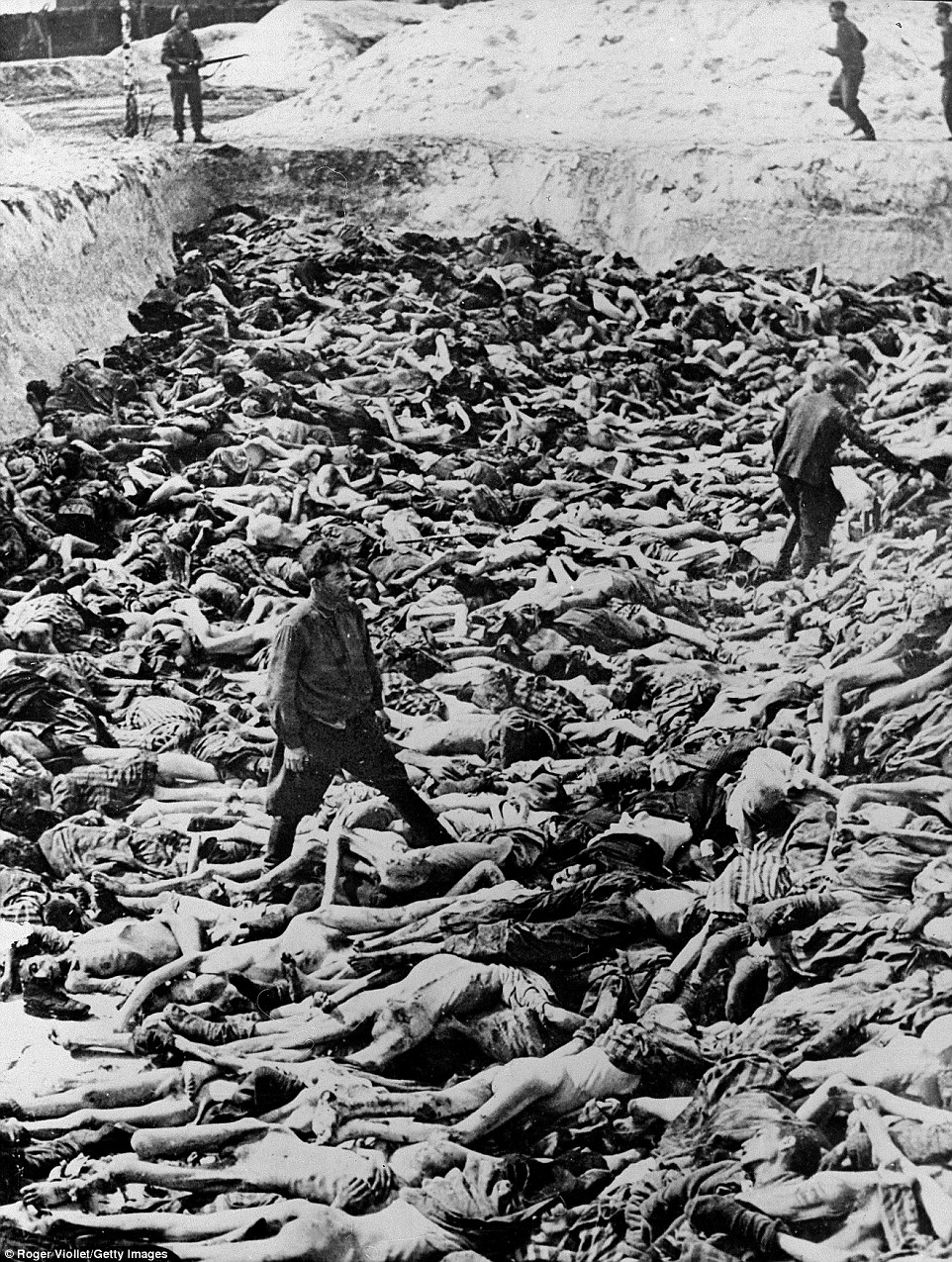
April 1945: Fritz Klein, a Nazi camp doctor who conducted medical experiments on prisoners during the Holocaust, stands among corpses in a mass grave after the liberation of Bergen-Belsen, Germany. Of the 38,500 inmates found barely alive after liberation, about 28,000 subsequently died. Watched by British soldiers, Klein is pictured here being forced to bury the dead. That December, he was sentenced to death and hanged for his role in the atrocities. Bergen-Belsen was the first Nazi camp to be liberated - and gave the world some of the first visual evidence of the horrors of the Holocaust
Aylan Kurdi's body is among photos that have changed history
